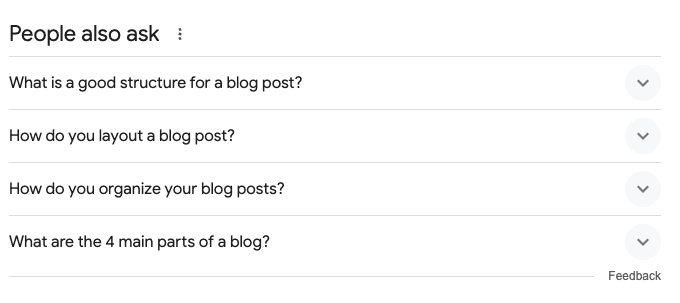Writing blog posts takes time and effort. You can hire a blog writer to produce the content for you, but that costs money. If you’d rather do it yourself, you need a solid framework to publish blog posts that engage readers, instead of putting them to sleep. I’ve got a 6-step blog writing framework you can follow to write better articles, in less time.
1. Choose A Topic
You can’t start writing until you know what you’re writing about. That’s where topic research comes in. The best topics to write about are ones your potential customers will find interesting. After all, what’s the ultimate goal of content marketing if not to attract new business?
Start by thinking about your current customers. What sort of problems do they need solved that you could write about? Are they about to move home and need some helpful packing tips? Do they have neck pain and want to know the difference between a chiropractor and a physiotherapist, so they can tell which is right for them?
If you’re not sure where to start, some great ways to find topics are:
- Survey your existing customers what they want to read about
- Ask your staff to come up with content ideas
- Look at your competitor’s blog and see what they post about
- Brainstorm complementary topics to your most-read articles
- Use online tools such as Semrush’s Topic Research tool or AnswerThePublic
- Think of questions you had when you were new in your industry, and write posts that answer them
2. Conduct Keyword Research
If you’re going to write blog posts, it’s a great idea to optimise them with keywords. This helps you rank the articles higher in search engine results pages (SERPs). Multiple studies suggest that around 50% of online traffic comes from organic searches. So if you don’t optimise your posts with keywords, you’re missing out on a LOT of potential traffic.
The simplest way to conduct keyword research is by using paid tools like Semrush and Ahrefs. However, these are very expensive (the pro versions cost hundreds of dollars per month).
If you want a more cost-effective keyword research method, here’s one I follow:
- First, download the Keywords Everywhere extension for your web browser. This is a low-cost tool you can use to estimate keyword volume (the budget option costs around $2 per month).
- Next, type in the topic you want to write about on Google. The Keywords Everywhere tool will estimate the volume of monthly searches that topic has. It will also suggest related keywords and provide their volume as well. Aim for keywords with at least 10 searches per month.
- Higher volume is good, but it generally means higher competition. There’s no point ranking on page ten for a keyword with 1,000 monthly searches because 75% of people will never scroll beyond the first page.
- For any query you type into Google, look at the top-ranking websites and see what you’re up against. Stay away from topics where top spots are occupied by much larger websites than yours.
- Use the MozBar to measure a site’s Domain Authority, which is a metric that predicts how well a website will rank on search engines. If the first page only has websites with a DA higher than 50, and yours is less than 10, you’ll have trouble outranking them.
- For more potential keywords, look at the “people also ask” and “people also search for” features on Google. These will also provide ideas on the specific content to include in your blog article.

This is a basic overview of how to conduct keyword research. It’s just one way to go about it. In reality, there are many methods to that work. Find what produces the best results for you and refine your method over time.
3. Create An Outline
You’ve probably heard the Abraham Lincoln quote about cutting down a tree:
“Give me six hours to chop down a tree and I will spend the first four sharpening the axe.”
When it comes to writing a blog post, this is sound advice too. Not that you should spend 4 hours sharpening an axe – but you should spend much of your time on preparation. That means conducting keyword and topic research and then creating an outline for the post. Doing these crucial steps well will make it WAY easier to write the article.

A blog post outline should include:
- Main headline
- Introduction
- Sub headlines
- Key points under each sub-headline
- Supporting data or quotes
- Conclusion
- Call-to-action (CTA)
Bonus tip: Include the keywords you want to rank for in your headline and sub-headlines. Don’t overdo it, though! Try to weave them through in a natural-sounding way.
4. Write The Introduction
The introduction is one of the most crucial parts of your blog post. It’s your chance to grab the reader’s attention and convince them to keep reading. A well-crafted intro sets the tone for the rest of the article and provides a clear indication of what the reader can expect.
Here are some tips for writing an engaging introduction:
- Keep it short and to the point. If you waffle on too much, you’ll lose the reader’s attention!
- Use a surprising fact, question, quote, or personal anecdote to draw readers in.
- Preview the content by giving a brief overview of what the reader will learn or gain from reading the post.
- Use a conversational tone to build a connection with the reader. Write as if you’re speaking directly to one person.
- Include your keywords to set the stage for SEO right from the beginning.
5. Build The Body Paragraphs
After you’ve hooked readers with your intro, you’ll need to hold their attention throughout the rest of the article. The body paragraphs form the core of your blog post. They should provide valuable information, insights, and solutions to the problems of your reader.
Here are some tips to write better body paragraphs:
- Use subheadings to break up the text and guide the reader through your points.
- Focus on one idea per paragraph to maintain clarity.
- Provide practical tips, actionable advice, and relevant examples.
- Support your points with data, stats, or quotes from experts.
- Include images, or even infographics, to illustrate your points.
- Include internal and external links to relevant resources.
- Use bullet points to highlight key information and break up long sections of text.
6. Close With A Conclusion And CTA
Just like a movie needs a great ending, your blog post needs a strong conclusion. A well-crafted conclusion summarises your main points. It’s your chance to include any final thoughts on the topic. This reinforces the value of your content and leaves a lasting impression.

Your conclusion should also leave readers with a clear next step. This is where a call-to-action (CTA) comes in. Your CTA might suggest the reader to:
- Purchase a product that’s been mentioned in the article.
- Book a call to discuss their problem in greater detail.
- Start a free trial of your software that can save them time, money, or effort.
- Subscribe to your newsletter for more valuable tips and information.
- Download a free lead magnet that solves a common pain point.
- Read another article on a related or similar topic.
Bonus tip: Afraid of selling? Don’t worry. You don’t have to turn into a snake-oil salesman in the conclusion. But including a CTA that’s relevant to the blog post’s topic can be helpful to the reader – and it’s a great way to move them towards becoming a paying customer.
Summing Up…
Creating engaging blog posts doesn’t have to be a daunting task. With this 6-step framework, you can organise your ideas and produce compelling content efficiently. If you need more guidance, another resource you might find helpful is this list of blog post formats. Of course… if you’d rather outsource your content to a professional, I offer blog writing services at an affordable rate!
